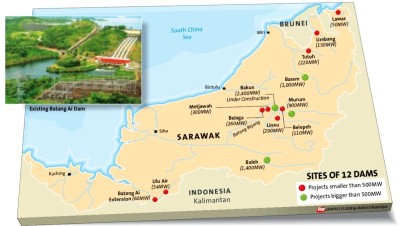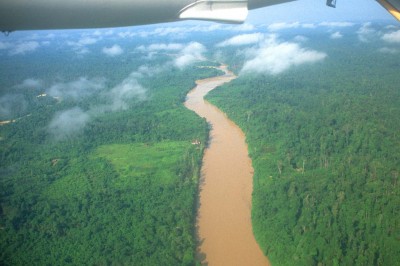A consideration regarding the inconsistency between the national energy policy and the building of 12 dams that in a mere 10 years will generate 600% more power than current demand.

Sarawak, the largest state in Malaysia, has a population of approximately 2.3million. In its aims to be a developed state along with the rest of Malaysia by 2020, has over the years embarked on several quests to economics initiatives to transform its agriculture based economy into a more industrialised one, while developing its commercial agriculture in tandem.
Supporting this transformation and its population growth, is a network of power generators located in the major city of the state. Combined, these generators have a capacity of 1300MW, which includes a comfortable reserve margin of 40% from the state’s peak demand of 900MW.
Hydroelectric in the energy mix
Today, Sarawak generates 9% of its power by hydropower. By 2013, this figure poised to increase significantly – through the completion of the controversial Bakun and Murum dams with a combined capacity of 3300MW, or 72% of the state’s energy mix.
With Bakun and Murum connected to the grid, Sarawak will have an alarming reserve margin of 410%. Lack of committed taker for the energy fuels are causing concerns of an imminent energy glut in the state.

(Source: The Star)
Without a concrete plan to address the energy glut, the State energy producer sparked further controversy through a presentation entitled Chinese Power Plants in Malaysia – Present and Future Development in October 2009 during the China-Asean Power Cooperation and Development Forum in Nanning, China.
In this presentation, Sarawak plans to build 12 additional dams to fulfil future, uncertain industrial demands. The planned dams will be built in Ulu Air, Metjawah, Belaga, Baleh, Belepeh, Lawas, Tutoh, Limbang (feasibility study commenced), Baram (pre-feasibility study commenced), Murum (construction starts 2011) and Linau rivers.
The plan will also include an extension to the existing Batang Ai dam (detailed study commenced). When all these dams are completed, they will push the total power capacity of Sarawak to 7000MW by 2020 – a whopping 600% more than the current demand.
Questions that arise are, why has there not been any public engagement when the feasibility studies for some has commenced? And which economy in the world will grow by 600% in 10 years?
Another reason which concerns environmentalist is the presentation above was not made public, but was accidently published in a Chinese website. Implementing projects of such magnitude and socio-environmental impact without consulting the public does not go down well with the people, especially after the bad experience with Bakun.
Proposed Dams and Social Impact
Without committed take-ups for the excess power, these dams seem poised to end up as white elephant projects at the most severe expense of the of the affected ecosystems and communities. These dams potentially displace thousands of people and submerge several Penan, Kelabit and Kenyah villages.
One of the said dam, Tutoh dam, may submerge part of the Mulu National Park, a UNESCO World Heritage Site.

The Sarawak government’s proposal to build the dams, and then start looking for users for the energy generated, reflects the inconsistencies in the country’s energy and environment policies. It also illustrates a planning strategy that is supply driven and therefore inconsistent with the principles of sustainable development.
While hydro power was controversially categorised as renewable energy, its adverse environmental and sociological impacts have also been identified during and after many reservoir constructions. Throughout the life cycle, whether hydro power ultimately is beneficial or detrimental has been debated since the 1960s.
The damming of a river creates a reservoir upstream where waters spill out into the surrounding environments, flooding the natural habitats that existed before the dam’s construction – completely destroying and eliminating all lifeforms within the perimeter of the dam. These lifeforms include carbon rich plants and trees that upon death releases large amounts of carbon into the atmosphere.
There is also a school of thought claiming that the high amount of biomass converted into methane results in pollution potentially 3.5 times more than an oil-fired power plant would for the same generation capacity. This is because large amounts of carbon tied up in trees and other plants are released when the reservoir is initially flooded and the plants rot. Then after this first pulse of decay, plant matter settling on the reservoir’s bottom decomposes without oxygen, resulting in a build-up of dissolved methane. This is released into the atmosphere when water passes through the dam’s turbines.
The impact to global warming is significant because methane’s effect on global warming is 21 times stronger than carbon dioxide’s.
Sarawak, the Dam-ed State
As it stands today, when the 12 new dams complete according to the State’s plan, hydro will make up 85% of the total generation in Sarawak, making the state, a Dam-ed state.
Related Internet Links:

@ALL : the easiest way we can do to address energy issue, is to be informed and be efficient ourselves.
Cp
I know that being pro-active to accommodate the state’s potential energy demand is a positive action, but we all know that there is a limit to how much should be planned. A 600% increase from the current demand does not seem like a justifiable number for a 10 year growth plan. Just like Bobby said, industrial estates have to be built in order to utilize the excess power supply. So yeah, Asians are still the white man’s slave :(
Politics aside, the contruction of the dams, and the exorbitant costs involved in planning do not make any economical sense.
We should be moving towards conservation of energy. It is scary how we fail to study the repercussions of our actions carefully,almost always.
Why do we always put the cart before the horse?
White Hair wins all!
i. Forest reserved got excuse to chop down to retrieve kayu balak(WH)
ii. Building dams major cost concrete which is from CMS(WH)
iii. Construction co's linked to WH
iv. Electricity generated selling by SESCO(WH)
v. Smelting plants joint venture btw foreigners and WH
and the list goes on and on.
In short, WH is winning King all the way. Go,go,go … you are the Champion.
mimisuku, looks like the current Sarawak CM, the infamous Pek Mo is contributing much to Sarawak. After 30 years in power, Sarawak seems to have "overtaken" other state in terms of development.Well, at least one Sarawakian & his family has prosper with billions of RM of properties all over the world. Sarawakian should be proud. Why take the risk of choosing for another party which has not proven thier "ability" like Taib? Sarawakian should just stick to Taib until an angel(a proven one??!!) has arrived. The motto is to choose the evil you know than the angel you don't.
Methane is described as having around 23 times the greenhouse impact of the same weight of CO2, mainly because of its longevity. Also, the amount of concrete and steel used in large dams is staggering, and their manufacture produces a poportional amount of GHG. History has shown that dams last only 3 to 5 decades before failing catastropically or needing major repairs. These repairs and desilting of the reservoir are costs hiddden at the outset.
Halo friend,
How can `Sarawakians' vote a different government when
* half the eligible citizens in the rural areas ie 90% of Sarawak, has not been registered as voters due to distance and lack of information?
* there is a lack of accurate information that will reach the largely illiterate folks -especially the older generations who are the majority registered voters;
* there is a state apparatus ever vigilant to snuff any sign of opposition from the people
* Then you ca ask the opposition parties-where are they?
Hope you can do something positive about this before you bark up the wrong tree!If you are interested to do something positive about Sarawakians' situation eg uphold their rights to vote, you can always look up our site http://sarawaknews.wordpress.com for reference.
Why should Sarawakians vote for West Malaysian parties who does exactly the same thing? The only difference is who is the lesser evil? See what happens to Sabah when they opened up the flood gate. I'm not pro-BN nor am I pro-opposition (as what ruling-party lackeys likes to call). As for DAP Sarawak, oh well, what can I say. Even though they have won Sibu just this year, it's still remains to be seen on how Wong Ho Leng will perform his duties.
Let me ask you a question Foo Wy Len: So you are suggesting "we" Sarawakians NOT to vote for the ruling party for the sake of NOT voting for the ruling party?
There's much development to be done. Fortunately there are less social/racial issues in Sarawak as faced in West Malaysia, as we all see and read in the papers on how the numero uno ruling-party can utter remarks telling all the China man (and women) to return the Chinaland if they don't like how things are done?
And nobody's perfect, opposition or not, ruling or otherwise. You should be clever about who/or which group to pick, on whether they can (or can not) deliver improvements and developments to the state.
When will the Sarawakians wake up from their slumber? If you consistently voted in the SAME govt elections after elections, can we blame anyone else? After all you deserve what you have chosen!
Tujuan sebenar ialah hendak mengluar kayu balak dikawasan2 yang hendak di tenglamkan sama seperti Bakun